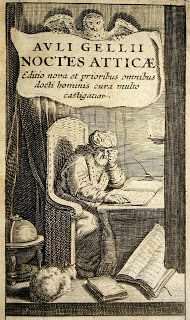 Last week I blogged about an old reading-and-riding exercise-chair at Belton House in Lincolnshire. Coincidentally, an article by Charles Nicholl in the Guardian on Saturday set about describing a different reading chair. No longer surviving today, this one belonged to the poet and playwright Ben Jonson. It is documented by the Restoration virtuoso John Aubrey, who reported having seen ‘[Jonson’s] studyeing chaire, which was of strawe, such as old woemen used’. Aubrey compared it with the chair shown in a picture of the Latin writer Aulus Gellius.
Last week I blogged about an old reading-and-riding exercise-chair at Belton House in Lincolnshire. Coincidentally, an article by Charles Nicholl in the Guardian on Saturday set about describing a different reading chair. No longer surviving today, this one belonged to the poet and playwright Ben Jonson. It is documented by the Restoration virtuoso John Aubrey, who reported having seen ‘[Jonson’s] studyeing chaire, which was of strawe, such as old woemen used’. Aubrey compared it with the chair shown in a picture of the Latin writer Aulus Gellius.
Further sleuthing allows Nicholl to establish that Jonson’s chair was on display for part of the seventeenth century in a ‘tippling house’ (The Jonson’s Head) on the Strand, where a poetaster pinned some rather lame verses above it, and the wits quipped that it signified ‘that Poets in these hard times, though they should invoke the nine Muses, may still want nine pence to purchase a pint of Canary’.
To some, all of this harping on a long-lost chair will seem fatuous. But scholars are increasingly turning to literary relics and souvenirs, both as a way of gauging the development of a writer’s reputation over time, and of charting changing ideas about the nature of the creative process. It would be nice to know what became of this particular seat of learning.